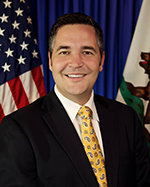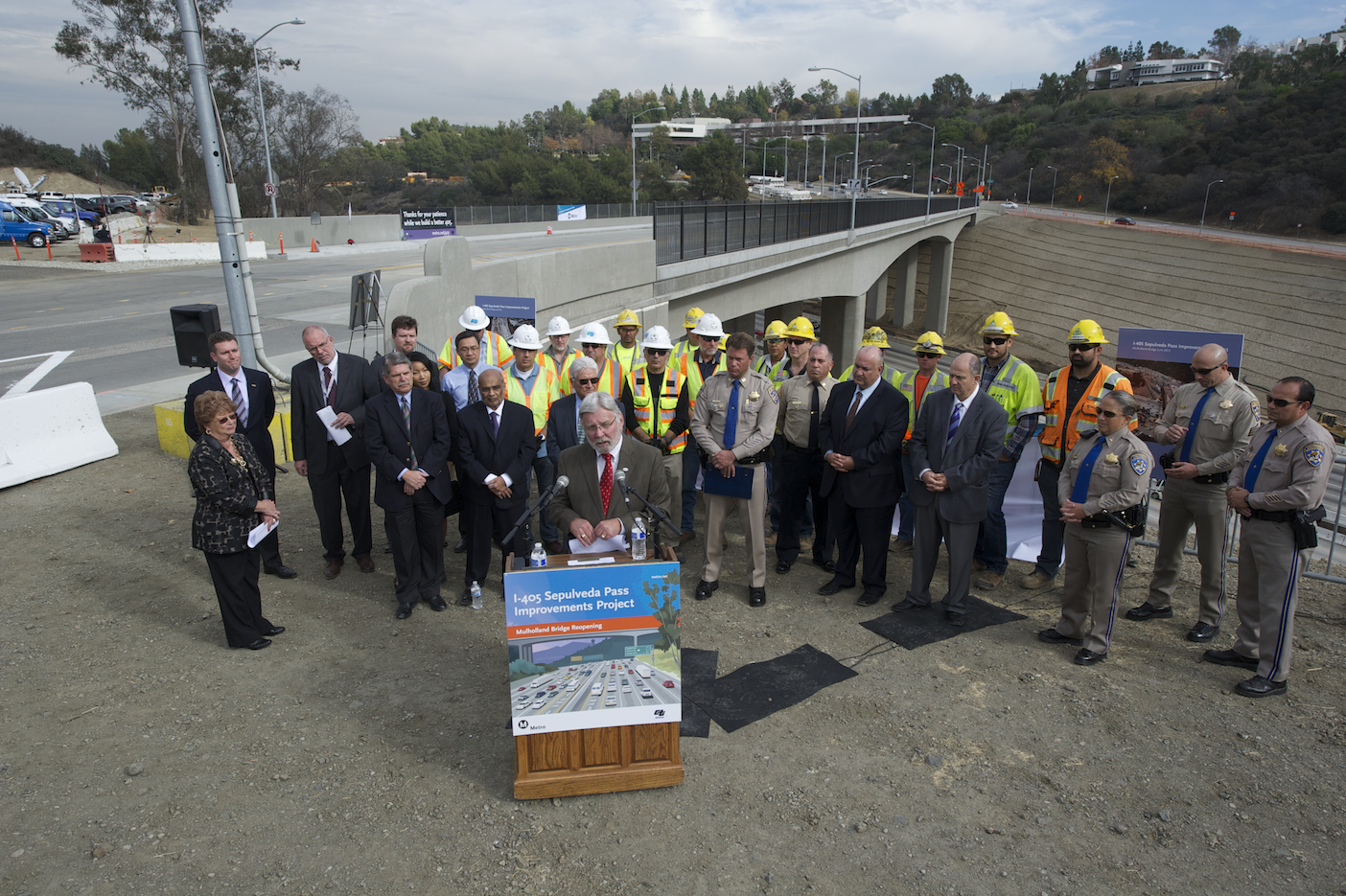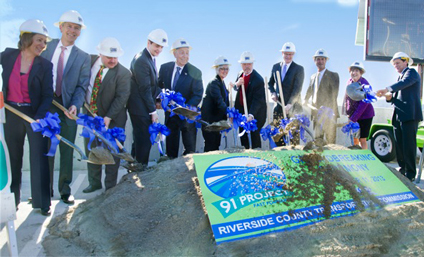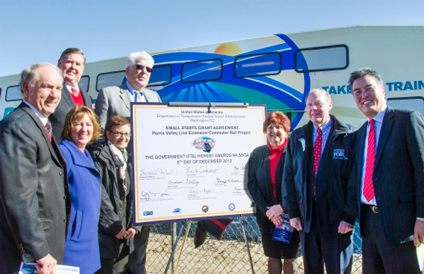Mobility 21’s Year in Review
Season’s greetings from Mobility 21! This year, Mobility 21 continued to expand its network to help bring investment to Southern California’s transportation system. With your help, we influenced important legislation and celebrated several milestone moments. Here are some of Mobility 21’s highlights from 2013:
- Mobility 21 testified before members of the House Transportation & Infrastructure Committee on strategies for goods movement investment in Southern California.
- Mobility 21 hosted the first Mobility 21 Legislative Dinner to honor “Champions of Transportation.” The event in Sacramento attracted more than 100 people, including elected officials, transportation leaders and business professionals.
- Mobility 21 advocated for the inclusion of Southern California representatives on the National Freight Advisory Committee, which resulted in the appointment of Assemblymember Bonnie Lowenthal, California Transportation Commissioner Fran Inman, Port of Hueneme Executive Director Kristin Decas, and University of Southern California’s Gen Giuliano to the committee.
- Mobility 21 met with legislators in Washington, D.C. during its annual advocacy trip to communicate transportation policy priorities for Southern California.
- Mobility 21 advocated for the passage of AB 401 (Daly) to provide regional transportation agencies unlimited design-build authority for street, road and highway projects until 2024 — expediting project delivery and job creation.
- Mobility 21 strongly supported AB 1222 (Bloom and Dickinson) to provide a path to resolve the dispute blocking federal transit grants from flowing to agencies around the state.
- Mobility 21 supported applications from Southern California for the U.S. Department of Transportation’s TIGER grant program, resulting in a funding allocation for the San Diego Association of Governments’ Pacific Surfliner Bridge Replacement Project.
- Mobility 21 co-hosted a reception at the historic Mission Inn in Riverside to honor members of the California Transportation Commission.
- Mobility 21’s Annual Transportation Summit gathered more than 1,000 transportation leaders and professionals at the JW Marriott at L.A. Live on Oct. 29.
- Mobility 21 unveiled a mobile web application for transportation advocacy.
- Executive Director Marnie O’Brien Primmer was named ENR’s Top 20 Under 40 and OC Metro’s 20 Women to Watch in 2013.
Assemblymember Eric Linder Shares
New Perspective on Transportation
 This month we turn our attention to Assemblymember Eric Linder to hear about his first year as Vice Chair of the Assembly Transportation Committee. Elected to the California State Assembly in 2012, Assemblymember Linder currently represents California’s 60th Assembly district which encompasses the cities of Corona, Eastvale, Jurupa Valley, Norco and Riverside.
This month we turn our attention to Assemblymember Eric Linder to hear about his first year as Vice Chair of the Assembly Transportation Committee. Elected to the California State Assembly in 2012, Assemblymember Linder currently represents California’s 60th Assembly district which encompasses the cities of Corona, Eastvale, Jurupa Valley, Norco and Riverside.
M21: What are your reflections after serving your first year as Vice Chair of the Assembly Transportation Committee?
AL: Not being involved with the legislative process prior to coming to Sacramento, I really had no idea what to expect but being named the Vice Chair of Transportation, a vitally important issue for my District, was very exciting to me. Looking back on it I am very proud of what the committee was able to accomplish in my first year. Most notably helping and co-authoring AB 401 (Daly) which expanded the ability to use design-build statewide. This tool is already in practice in my district for the expansion of the 91 freeway and there is no doubt that the project is years ahead of where it would be without design-build. Not to mention that the 91 freeway expansion is expected to bring over 16,000 jobs to the region.
M21: What do you believe are the three most important transportation policy challenges for the legislature to tackle in the upcoming year?
AL: Funding, funding and funding. There are always several issues in transportation that are pressing and should not be dismissed, such as much-needed CEQA reform and having the best tools to efficiently design and build our infrastructure, but there should never be a doubt that meeting our funding obligations for our current infrastructure needs is the most pressing matter. For years, Sacramento has siphoned money away from our infrastructure in order to pay for different programs and it has led to an expected $300 billion shortfall to just meet our existing needs. This has to be addressed in a way that protects taxpayers and ensures our infrastructure returns to being the envy of the world.
M21: A lot of discussion lately has focused on how we will pay for the transportation system moving forward. What are your thoughts on this?
AL: There are very few easy answers on funding our transportation system moving forward. Ideas have been tossed around like the proposed ballot measure to increase Vehicle License Fees or tracking mileage driven in the state. All have their positives and negatives and will adversely affect some more than others. The legislature needs to examine every proposal out there and re-examine how we prioritize the state’s spending as a whole. Not every solution will work but until the conversation is had by the powerbrokers in California, which has been woefully absent to this point, it will never move beyond the discussion phase.
M21: What are some tips you have for transportation advocates who want to educate members of the legislature on their needs and concerns?
AL: Show them the need in their area. It is easy for legislators to view California’s transportation system in broad strokes, forgetting the real impacts it can have for their constituents. A poorly designed or out of date freeway impedes the flow of goods to the local grocery store or keeps parents tied up in traffic away from their kids. It is too easy to get caught up in the 10,000 foot view and forget that an added year in construction means another year of an increased disruption in people’s lives.
Yesterday, Metro held a press event announcing the reopening of the Mulholland Bridge over the I-405.
‘Carmageddon’ Bridge Reopens to the Public
The iconic Mulholland Bridge that spawned two unprecedented weekend closures of the nation’s busiest freeway and introduced the word “Carmageddon” into the American vernacular was fully reopened to traffic in Los Angeles at 6 a.m. Wednesday after nearly two and a half years of intensive bridge reconstruction work.
The return of the new bridge to full capacity is the latest milestone for the I-405 Sepulveda Pass Improvements Project, which is building a 10-mile carpool lane on the northbound I-405 between the I-10 and U.S. 101. As the administrator of the design-build project, the Los Angeles County Metropolitan Transportation Authority (Metro), and Caltrans, its project partner, have committed to continue opening parts of the massive freeway widening project as soon as they are deemed safe and ready for public use.
At 82 feet wide, 75 feet high and 608 feet long, the new bridge is both wider and longer than the original bridge built in 1959. It also has a similar lane configuration as the original bridge, but now has dual widened sidewalks, a widened center median, and is designed to meet the latest seismic standards. The bridge also now has four columns rather than the original bridge’s three for increased structural integrity. Most importantly, the bridge’s new columns are now in the proper location to accommodate the additional northbound 405 freeway lane that is currently under construction.
Approximately 20,000 vehicles travel over the bridge on a daily basis.
Transportation leaders from across California ceremonially break ground on the SR-91 widening at the North Main Corona Metrolink station.
Construction Breaks Ground on
91 Project in Riverside County
On Dec. 11, a throng of more than 400 people celebrated the beginning of construction for the widening of the 91 Freeway through Corona in Riverside County.
The $1.3 billion project adds general purpose lanes, tolled express lanes and provides a number of interchange improvements and is expected to create 16,200 jobs over the next three and a half years during construction. A number of federal, state and local officials attended a formal groundbreaking ceremony at the North Main Corona Transit Center to mark the beginning of construction including Brian Kelly, Secretary of the California State Transportation Agency.
“This project’s innovative financing approach supports important improvements to a critical link between the Inland Empire and Orange County,” said Secretary Kelly. “The Express lanes will give drivers new transportation choices while helping public transit and carpools reach more destinations.”
The Riverside County Transportation Commission (RCTC) is the lead agency for construction on the project which is being funding through a combination of sales tax bonds and the local Measure A Transportation Sales Tax program. The design-build project will be constructed by Atkinson-Walsh a joint venture which has opened offices in Corona.
Nearly 280,000 vehicles travel SR-91 daily, and this number is expected to grow by another 140,000 vehicles daily by 2035. Once completed in early 2017, the 91 Project will expand transportation choices, reduce delays, allow faster emergency response, relieve local street congestion, and offer better access to public transit and trails.
Local officials including Corona Mayor Karen Spiegel who also serves as the Chair of RCTC are eager for the project to get started. “We have needed a significant and lasting improvement to this freeway for decades,” said Spiegel. “This project, along with other transit improvements including Metrolink and bus service from RTA and OCTA will truly change life for the better for those who depend on this corridor.”
A concerted public outreach campaign will be conducted to alert commuters and residents of construction impacts of the project. Those seeking more information can access the project website at http://www.sr91project.info.
Mayor Spiegel also urged patience during the construction period. “Construction projects like this can be inconvenient while they are being built, but will offer lasting benefits for generations to come,” said Spiegel. “Learning to appreciate construction is part of our investment in a better future.”
SANBAG Board Advances Express Lane
Alternative for I-10 and I-15
The Express Lane conversation remains active as various counties throughout the region discuss the alternatives for addressing the challenges faced by each respectively. After an extensive study period to assess the viability of an Express Lane alternative for Interstate 10 and Interstate 15 in San Bernardino County, the San Bernardino Associated Governments (SANBAG) Board of Directors acted to continue studying Express Lanes as an alternative through the environmental phase of project delivery.
Detailed information regarding the design, traffic and revenue, finance and equity study results for the I-10 and I-15 Corridor Improvements was provided at an October SANBAG Board Workshop and other related meetings. The Express Lane design and financing plans were determined to be viable based on preliminary engineering and traffic and revenue studies. A complete financial analysis supported those conclusions. In addition, an equity study was completed and addressed concerns about the potential impacts Express Lanes may have on low-income populations who currently use these corridors.
During this study period, a robust public outreach program has been conducted to inform the public of the proposed improvements and to receive community feedback. Before seeking direction from the Board, SANBAG staff shared the findings with three community advisory groups to gain additional input that could prove valuable for SANBAG Board members as they considered their options for addressing the demands of these two corridors.
Moving forward, there are additional decision points for the SANBAG Board during the environmental process. Specifically, the Board will give direction on a Locally Preferred Alternative, which occurs after the completion of the technical studies. Selection of a Preferred Alternative to be constructed will follow after responding to the public comments and prior to approval of the environmental document.
Construction Starts on SR-11
To Ease Border Area Congestion
After more than a decade of planning, the San Diego Association of Governments (SANDAG) and Caltrans recently broke ground on a major project to build critically needed border infrastructure – a new freeway and eventually a new port of entry in Otay Mesa – to cut border wait times and boost crossborder trade.
Estimated to cost $700 million to $750 million, the State Route 11/Otay Mesa East Port of Entry (POE) project is the result of collaboration by a number of key local, state and federal agencies in both the United States and Mexico, including the General Services Administration, U.S. Customs and Border Protection, the U.S. Department of Transportation, the Federal Highway Administration, Mexico’s Secretaría de Comunicaciones y Transportes, Secretaría de Relaciones Exteriores and Mexican Customs/Aduanas.
Currently, all border crossings between the San Diego area and Tijuana are congested, with border wait times routinely exceeding two hours at the existing Otay Mesa and San Ysidro ports of entry. Border traffic congestion and delays cost the U.S. and Mexican economies an estimated $7.2 billion in gross output (value of goods and services produced) and more than 62,000 jobs in 2007 (the latest data available). The annual dollar loss is equivalent to 18 Super Bowls. In addition to economic loss, border congestion is also detrimental to air quality.
Officials and elected representatives from both sides of the border attended a groundbreaking ceremony on Dec. 6 for the first segment of the project.
“This project is a shining example of productive partnerships on both sides of the international border as we continue to plan and implement transportation solutions,” said Caltrans District 11 Director Laurie Berman. “If it were not for the passage of Proposition 1B by voters back in 2006, this project would not be breaking ground today.”
The SR 11/Otay Mesa East POE project will be built in three phases. The first segment, which starts construction this month, will build a stretch of the freeway from SR 905 east to Enrico Fermi Drive and the SR 905/SR 11 freeway-to-freeway connectors, linking the future port to the rest of the highway system. This segment will cost $112 million, with $71 million coming from the state’s Proposition 1B Trade Corridors Improvement Fund and $41 million from the federal Coordinated Border Infrastructure program. Coffman Specialties Inc. of San Diego is the contractor for the first segment, which is expected be completed in 2015.
Segment Two will extend SR 11 from Enrico Fermi Drive to Siempre Viva Road and include a new Commercial Vehicle Enforcement Facility (CVEF). The entire length of the highway will be 2.5 miles. Segment Three will build the new Otay Mesa East Port of Entry. The last two phases will be built as funding becomes available.
Future plans call for toll roads approaching the border crossing both north and south of the border – allowing travelers the opportunity to pay a fee to get to the border more quickly, drastically reducing the lengthy wait times they currently endure.
“This is a big step toward eventually building a fourth port of entry in the San Diego region,” SANDAG Chair and Santee Councilmember Jack Dale said. “The innovative new crossing will make it possible for commercial and private vehicles willing to pay a toll to get across the border in a secure way and quickly, cutting congestion and giving a big boost to our local and state economies.”
Caltrans is the lead agency for the planning, design, and construction of the toll road portion of the project. SANDAG is the tolling authority, and is also spearheading the design and construction of the port of entry.
SCAG Co-hosts Economic
Recovery & Job Creation Summit
Unprecedented levels of collaboration at the federal, state and local levels regarding job creation. Workforce development, project streamlining, tax credit incentives and eliminating non-performing programs. These were among the recommendations from speakers at the 4th Annual Economic Recovery & Job Creation Summit co-hosted by the Southern California Association of Governments (SCAG) and the Southern California Leadership Council (SCLC) in downtown Los Angeles on Thursday, Dec. 5. More than 300 local and state elected officials, public and private sector CEOs, business and labor leaders, stakeholder agency representatives and city managers came together for the formal release of the economic outlook reports for Imperial, Orange, Los Angeles, Riverside, San Bernardino and Ventura counties and the region’s poverty report – and to find ways in which we can build a stronger, more prosperous and sustainable Southern California.
Numbers released at the Summit showed that 3.2 million people in SCAG’s six-county region lived in poverty in 2012, up from 1.9 million in 1990. Summit speakers and attendees spoke passionately about the importance of developing education and training programs that meet employers’ needs, which will result in more jobs and restore a middle class that has gradually eroded during the past 20 years.
Moderated by KNX 1070 Newsradio’s Frank Mottek, the summit featured substantive and meaningful insight from keynote speaker California State Senate President pro tempore Darrell Steinberg and a number of outstanding economists from across the region. Additionally, this year’s summit garnered local, national and international media attention from a host of news media organizations and publications including the Los Angeles Times, Univision, China News Daily, CBS 2 News, KNX 1070 Newsradio, KABC AM 710 and others.
For more information about the Summit and to view Summit materials, visit http://economy.scag.ca.gov.
FTA Deputy Administrator and Reps. Calvert & Takano gather with RCTC and Metrolink leaders at the Perris Transit Center to sign a $75 million grant for Perris Valley Line.
FTA Awards $75 Million for
Perris Valley Line Metrolink Extension
The Riverside County Transportation Commission (RCTC) welcomed Federal Transit Administration (FTA) Deputy Administrator Therese McMillan to Perris on Dec. 9. The purpose of her visit was to award $75 million in federal grant funding for the Perris Valley Line extension of Metrolink.
During a formal ceremony held at the Perris Transit Center, McMillan was joined by local Congressmen Mark Takano (D-Riverside) and Ken Calvert (R-Corona), who both sought funding for the project along with Senators Dianne Feinstein and Barbara Boxer.
A number of local officials also participated in the formal grant signing ceremony. “Public transit is becoming an especially important part of our transportation network in Riverside County,” said RCTC Chair Karen Spiegel, who is also the Mayor of Corona.
“By bringing Metrolink to more of Riverside County, we create a foundation to make the rest of our public transit and overall transportation even stronger.”
The $247 million project will extend the current Metrolink 91 Line by 24 miles and will include new stops in Perris, South Perris/Menifee, March Air Reserve Base and the Hunter Business Park in Riverside.
RCTC bought the rail right of way for the project in 1992 and will begin construction this month. The construction will include track improvements, double tracking in some areas, the construction of new stations, and improved signaling and safety systems.
Prior to the formal signing ceremony, FTA Deputy Administrator McMillan hosted a roundtable discussion with local government and business leaders. The session offered an opportunity for local interests to provide input to the FTA and other federal agencies on local needs and concerns. One topic that was frequently raised was the nexus between transit investments and the local economy and was raised by Riverside County Supervisor Marion Ashley and Perris Mayor Daryl Busch, who also serve as officers on the RCTC Board.
“The communities in this area were hit hard by the most recent recession,” Ashley said. “By providing people choices, we provide them with new opportunities and it’s an investment that’s been needed for a long time.”
“Rail service has always been a priority in my community and is ingrained in our history and it’s going to be an important part of our future too,” said Busch. “Transportation can be the lifeblood and foundation to fuel our economy.”
The Perris Valley Line service is expected to open in mid-2015 and is expected to carry more than 4,000 passengers per day.
Orange County Transportation Authority employees celebrate the authority’s award recipients at the annual WTS Orange County Gala.
OCTA Employees, Freeway Project Win Awards
More than 300 members of Orange County’s premier transportation professional association celebrated the progress of women in the field at a special awards and scholarship event this month.
Two Orange County Transportation Authority (OCTA) employees were recognized for their outstanding work as leaders in the transportation industry during the WTS Orange County’s 25th annual Scholarships and Awards Gala. OCTA’s West County Connectors project also received an award for its innovative approach to transportation and increasing mobility in Orange County.
Jennifer Bergener, OCTA’s Director of Rail Programs & Facilities Engineering, was honored as WTS Orange County’s 2013 Woman of the Year. She was selected because her career achievements have advanced the reputation and credibility of women in the transportation industry.
Jeannie Lee, OCTA’s project manager of Capital Programs, was selected as WTS Orange County’s 2013 Member of the Year. She received the honor for her extraordinary commitment to the goals of WTS Orange County.
The West County Connectors project was honored with the WTS Orange County 2013 Innovative Transportation Solutions Award. The $277 million project will improve traffic flow by linking carpool lanes on I-405 with those on SR-22 and I-605, creating a seamless carpool connection on the three freeways. The six-mile project, which traverses Garden Grove, Westminster, Seal Beach, Los Alamitos, Long Beach and Rossmoor, is set for completion in late 2014.
“We are so proud of the work being done by Jennifer, Jeannie and the staff leading the West County Connectors project,” Johnson said. “It’s an honor to see them recognized for all their efforts to improve our transportation system throughout the county.”

Early Bird Registration Closes this Friday!
New Partners for Smart Growth Conference
Feb. 13-15, 2014
Hyatt Regency Denver Hotel
Denver, Colo.
More info | Register
The 2014 New Partners for Smart Growth Conference is going mile-high – to Denver. The gateway to the Rocky Mountains, Denver is one of the nation’s most walkable and bike-friendly cities.
Founded as a boomtown on the western mining frontier, Denver has long fostered a strong sense of place, with urban parks, eclectic architecture and distinctive neighborhoods. Its dedication to sustainability is nurtured by an immutable geography that bequeaths clear blue skies, snowcapped mountains, majestic forests, cascading streams and panoramic open spaces. Denver exemplifies the smart-growth variety and vitality of a healthy, thriving city that balances development pressures and a rich quality of life for all its residents.
The 13th annual New Partners conference will explore practical strategies for identifying and overcoming barriers to more sustainable development in the Rockies and the rest of the nation.
Learn more about the latest in smart growth, including the latest research, cutting-edge implementation tools and techniques, best practices, model projects, policies and codes, and new partners. Most importantly, this dynamic event offers you the opportunity to network and coordinate with your peers as well as practitioners from many different disciplines.

2014 Los Angeles Economic Forecast Conference
Tuesday, Feb. 25, 2014
Loyola Marymount University
More info | Register
Enter promotional code “mobla14” when registering to receive $25 off!
Blending economic forecasts with surveys of residents and leaders, Forecast LA will include detailed insights into the most pressing economic and quality of life questions facing LA County and its nearly 10 million residents.
- Will LA County’s economy be better off by the end of 2014?
- How much damage has the political trench warfare in Washington, D.C. done to the economy?
- When will California’s red hot housing market begin to cool and by how much?
- Are Angelenos happy?
- Which industries are driving recent job growth the the US, California, and LA?
Transportation Events in the Community
Sunday, Jan. 12
WTS International Winter Reception at TRB
More info | Register
Thursday, Jan. 16
WTS-SD Luncheon Featuring Bill Fulton, San Diego’s Planning Director
More info
Tuesday, Jan. 28
WTS-IE: Annual Scholarship & Awards Benefit Dinner
More info | Register
Feb. 13-15
New Partners for Smart Growth Conference
More info | Register
Feb. 19-20
California Maritime Leadership Symposium
More info | Register
Thursday, Feb. 20
OCBC: Annual Dinner
More info | Register
Tuesday, Feb. 25
2014 Los Angeles Economic Forecast Conference
More info | Register
March 9-11
APTA: Annual Legislative Conference
More info | Register
May 5-8
Alternative Clean Transportation (ACT) Expo
More info | Register







